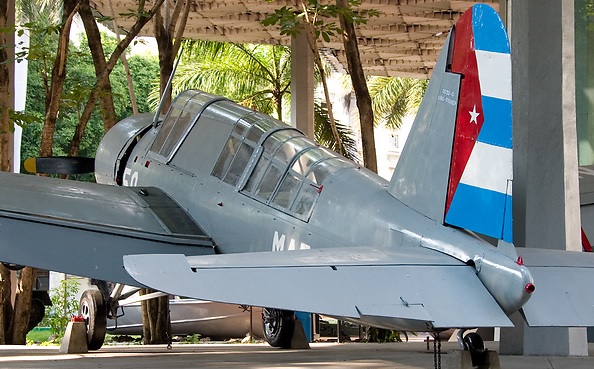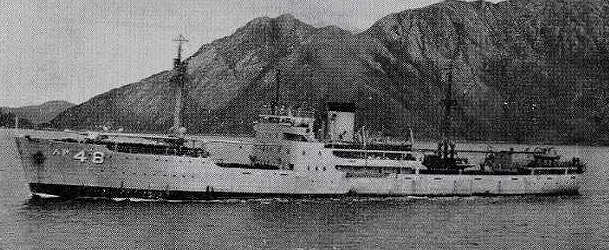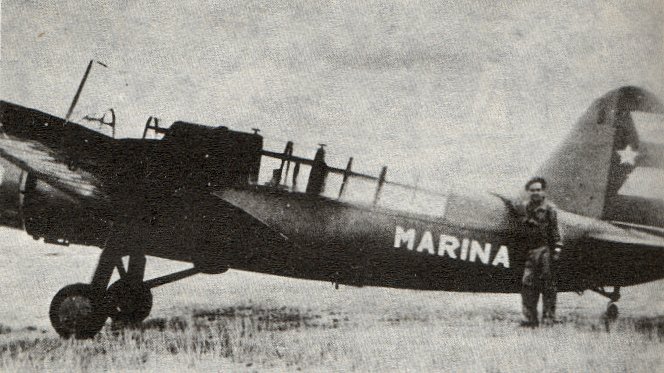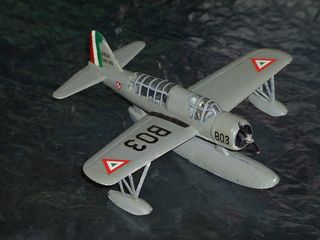(part 2 of a 2-part series)

(Cuban Revolutionary Navy OS2U Kingfisher.)
As catapult aviation met it’s demise in the USA, now-surplus Kingfishers were available for transfer to Allied navies for non-shipboard use.
Additionally, on some WWII-vintage warships transferred abroad after the war, the seaplane crane was retained as a useful asset even with the catapults gone. Below is the ill-fated Argentine cruiser ARA General Belgrano during the 1982 Falklands War, formerly the US Navy’s USS Phoenix (CL-42) during WWII.

Australia
The Royal Australian Air Force received eighteen Kingfishers during WWII. These had originally been ordered by the Netherlands for use in the Dutch East Indies, but diverted by the USA after the fall of Holland in 1940. They were assigned to the 107th squadron at Rathmines airbase north of Sydney. The planes were mostly painted grey on the undersides and a black/green camo on top, but were also used as experimental camouflage testbeds by the RAAF due to their large surface area for a single-engine type.

The Australians designated the type as Kingfisher A48. The RAAF’s Kingfishers made one unsuccessful attack against a sighted periscope but otherwise saw no combat during WWII. One unfortunate trait was that, for whatever reason, RAAF fighter pilots often mistook the Kingfisher for the Nakajima A6M2-N “Rufe” and several were nearly shot down by friendly fighters.

After the end of WWII, the Kingfishers were transferred to the freshwater RAAF Repair Depot at Lake Boga, Victoria. Many had the rear machine gun removed, or the WWII dive bombing sight removed, or both. From 1947-1948, one was loaned to the Royal Australian Navy’s Antarctic Flight, painted in bright yellow.

(artwork via Wings Palette website)
For part of the time, the Kingfisher operated with HMAS Wyatt Earp, a WWII-vintage light cargo ship converted into a research vessel. This ship had no catapult but could lower and retrieve the Kingfisher.

The wooden-hulled HMAS Wyatt Earp had originally been a Norwegian fishing vessel built in 1918. During the 1930s the ship was bought by an American adventurer and explorer who renamed the vessel after the wild west lawman. In 1939, with WWII approaching, the Royal Australian Navy acquired the ship as ‘hack’ auxiliary. The RAN sailors apparently liked the unusual wild west name enough to retain it.
After WWII, the antiquated vessel was ideal for Antarctic research as it’s lower hull had been iron-clad against ice, and the foredeck was big enough to store one plane, in this case a demilitarized and arctic-modified Kingfisher.

(Kingfisher and small landing boat aboard HMAS Wyatt Earp during a RAN scientific mission to Antarctica in 1947.)
HMAS Wyatt Earp and the modified OS2U Kingfisher were discarded in 1948. The remaining Kingfishers at Lake Boga continued to be used as test, training, and reservist proficiency planes at various RAAF bases until 1953. One RAAF Kingfisher survives in a Western Australia museum as of 2017.
Chile
Chile received 15 Kingfishers, first as WWII Lend-Lease and then as postwar surplus. The first were received in 1942. American military aid to Chile at the time was somewhat unorthodox; as the then-neutral country would not enter WWII until 1945. There was concern in Washington that WWII Lend-Lease to the OLARs (Other Latin American Republics, a general lump category) might result in a glut of weaponry in South America after peace came, that would destabilize the pre-WWII balance of power on the continent. The Chilean Kingfishers were transferred in part just to “even things out”.

(artwork via Wings Palette website)
Operating from ashore bases, the Chilean navy OS2Us were used in the maritime reconnaissance and search & rescue roles. There was one afloat mount, the multi-purpose auxiliary Angamos. This ship could not catapult a Kingfisher but had facilities to hangar one, put it in the water, and retrieve it.

(Chilean warship Angamos after WWII.)
During the late 1940s the Chileans removed some WWII-era gear off their Kingfishers. The dive bombing sight came off all, and some had the rear observer’s machine gun removed.
Like Australia, Chile considered the tough OS2U ideal for the harsh conditions of Antarctica. Chile’s relationship with the continent was different from that of Australia however. Prior to the 1961 international Antarctic Treaty, Chile claimed a region called TAC (Chilean Antarctic Territory, in Spanish) which was an uninhabited cone starting at the South Pole, from 53°W to 90°W longitudes.

(Chilean politicians, generals, and admirals in Antarctica during 1948. The Chilean military had modeled itself on the Wehrmacht during the 1930s and the headwear and coats still show WWII German styling influences here.)
During the early post-WWII period the country attempted to exercise direct sovereignty over at least the northern coastal fringe of this area and conducted military exercises there. Using Angamos as their mobile base, Kingfishers rotated to the area to fly reconnaissance missions reinforcing Chile’s claim. These rarely ventured more than several miles deep overland, as there was obviously not really much of anything to see.

(Chilean OS2U off the Antarctic coast during the late 1940s.)

(Chilean Kingfisher on an Antarctic reconnaissance mission. Typically Chile did not use the high-visibility international yellow, but retained a normal navy blue paint scheme to reinforce the notion that these were supposedly normal, unremarkable missions over the country’s own territory.)
Not all of the Kingfishers went to Antarctica. The balance remained in use as standard reconnaissance planes along Chile’s expansive Pacific coastline.

Chile retired it’s Kingfishers in 1957. One is today preserved in a museum. The WWII-vintage mobile base ship Angamos continued in service in other roles. It was not retired by the Chilean navy until 1967.

(photo by Carlos P. Valle via Jetphotos website)
Cuba
Cuba, at the time a strong American ally, declared war on Japan several hours after the United States did in December 1941, and then on Germany and Italy three days later. As part of the compensation for being allowed to build naval airbases in Cuba, the USA presented the Cuban navy with three of the ashore wheeled version Kingfishers in 1942. During WWII, the Cuban Kingfishers were used for u-boat patrols and to coordinate rescue efforts for ships sunk in the Caribbean.

(photo via airliners.net website)
The Kingfishers were well-liked by Cuban pilots. As they were direct military aid, not Lend-Lease, Cuba was free to retain them after the end of WWII.
All three Kingfishers were still in operational use when Castro’s communists overran their airbase in December 1958, and then when Castro took power in 1959.

(One of Castro’s fighters with a Kingfisher.)
The three Kingfishers remained in use in the reformed “Revolutionary Navy” in 1959. Clearly, there would never be any spare parts support coming from the USA now and in any case the planes were at or past their airframe fatigue lifespans anyways. They were retired later in 1960, with one being preserved as a museum display.
Dominican Republic
The USA loaned three Kingfishers to the D.R. air force during WWII. Like the British arrangement described below, the terms of the transfer required them to be returned at the end of hostilities and they did not serve long after WWII.
Mexico
Mexico declared war on the Axis in May 1942 and immediately received six Kingfishers from the US Navy. These were based ashore at Tampico and used for ASW patrols in the Caribbean. In February 1943, an additional six Kingfishers were delivered and formed into an independent observation squadron, patrolling both the Pacific and Caribbean coasts of the country.

(The TNCA E-1 Azcárate was a WWII Mexican-designed seaplane which served alongside the Kingfishers and was later replaced by them.)
There was no difference between the Mexican and American Kingfishers. Three of the Mexican planes retained floats, the other eight had fixed landing gear as they all operated from ashore naval bases anyways. Initially, the float versions were painted sea blue upper with light grey undersides, and the wheeled planes all-over dark grey to match runway concrete. The Mexican navy later determined that the grey was equally effective over water on hazy days, and at dawn / dusk, so most of the float version planes also received that paint scheme.

(Scale model of a Mexican OS2U in the post-WWII “concrete” color.)
The Mexican Kingfishers did not see combat during WWII. One of the twelve crashed in 1945 but the other eleven remained in use. After WWII, the Mexican Kingfishers were based at San Juan de Ulúa airbase near Veracruz. They remained in regular use throughout the late 1940s and the 1950s.

(Post-WWII Mexican Kingfisher crew in the late 1940s or early 1950s.)
Beginning in 1960 more modern types began to replace Mexico’s Kingfishers and the last was withdrawn in 1964. The Mexican navy donated it to the state of Alabama for display at the USS Alabama (BB-60) pavilion. Repainted in WWII US Navy markings, it was displayed for many years but nearly destroyed by hurricane Katrina in 2005. In 2008, the plane was patched up enough that it could again be publicly displayed but it still needs additional restoration.
Great Britain
The Royal Navy received a hundred Kingfishers throughout WWII under Lend-Lease contract #LL76493; not all were in use simultaneously however. The first arrived in May 1942. Of the hundred planes, about a third were based in Great Britain (mainly with the 778th Squadron at Arbroath), the balance being split up between the Mediterranean, South Africa, and Jamaica. The twenty-one planes in Jamaica were returned to the US Navy before the end of WWII.

None of the UK’s Kingfishers operated off Royal Navy battleships, however some served aboard armed merchant ships fitted with a simple catapult. Most were based ashore. They were used for training, rescue, and occasional u-boat patrols.
The Kingfisher’s post-WWII career in the UK was very brief. The terms of the contract stipulated that the paying “lease” portion kicked in if the aircraft were retained in service past a certain time after the end of hostilities; and there were additional restrictions on third-party transfers or modifications with non-American gear. After Japan’s surrender, the Kingfishers either had to be transported back to the USA at British expense or destroyed, and for the most part the latter was done.
Uruguay
Similar to the arrangement for Chile described above, the Uruguayan navy received six Kingfishers via Lend-Lease in 1942. The Lend-Lease contract listed their US Navy Bureau of Aviation serial numbers, which were six sequentially, indicating that they were most likely brand-new production.

(One of the Uruguayan Kingfishers on it’s WWII delivery flight. Unfamiliar with the distant country’s emblems, US Navy personnel mistakenly painted the wing roundel on the rudder instead of the national flag. The Uruguayan pilots did not want to cause offense and accepted them this way.)

(The error was rectified after WWII.)
Two of the six crashed during WWII from non-combat causes. By Christmas Day 1945, with American technical aid curtailed as WWII had ended three months previous, only two were fully operational. A major effort in 1946-1947 resulted in the other two returning to service.

The Uruguayan navy designated the Kingfisher as simply “OP” (Observación y Patrulla; or Patrol & Observation in English). Because the naval air wing was so small, they were numbered OP-1 through OP-6. They were assigned to the 1st Aeronaval Squadron. Often they flew out of Isla Libertad, an offshore rock that had a hangar and ramp especially for seaplanes.

(Isla Liberatad seaplane base)

(Kingfishers in formation over Montevideo.) (photo by Juan Trabal)
After WWII, these planes were used almost exclusively for search & rescue missions in the Atlantic. These planes were well-liked in Uruguay. The last was retired in 1958. In 1971, the Uruguayan navy returned one to the USA for museum display.

(The ex-Uruguayan navy Kingfisher which was repainted in late-WWII US Navy markings for museum display in the USA.)

(The Kingfisher was a popular type in service and well remembered in Uruguay.)

Living on the Gold Coast here in FL, I still get to spot a seaplane every now and then.
LikeLiked by 1 person
A fascinating couple of posts with some great photos. It’s certainly something I knew little about – until now!
LikeLiked by 1 person
Very interesting read.
The Soviets also used the Kingfisher until 1948 on the USS Milwaukee.
LikeLike